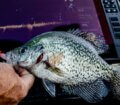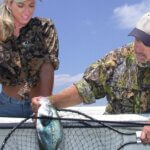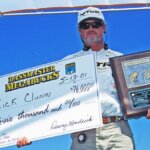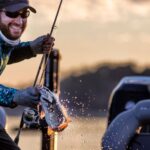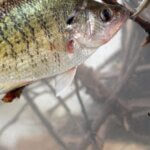Editor’s Note: With the strategies you’ll learn this week, you can develop a game plan on how to fish a new lake. With this information, a large number of potential crappie hotspots will come to mind. However, depending on the time of year you plan to fish, you also must consider where the crappie will be along their seasonal migration routes.
Fly Over a Lake and Use GPS: After studying the lake map and predetermining sites you want to fish, you also can find the most-productive places for crappie fishing inexpensively in the shortest time by flying over the lake and using a hand-held Global Positioning System (GPS) receiver to note the best crappie-looking sites. Shaw Grigsby of Gainesville, Florida, who’s won more than $2.5 million on the Bassmaster and Major League Fishing circuits in 39 years of bass fishing, not including sponsorship money, taught me to use my GPS for fishing. “John, as you fly over the lake, utilize your GPS receiver to mark underwater cover, ledges and drop-offs you won’t be able to see from your boat,” Grigsby instructed. “When you pass over stump rows, standing timber, deep drop-offs and any other area you want to fish, punch the QUICK-SAVE button on your GPS receiver to log the spot as a waypoint. Then when you get in your boat, you can find the places you’ve logged as waypoints on your GPS receiver.”
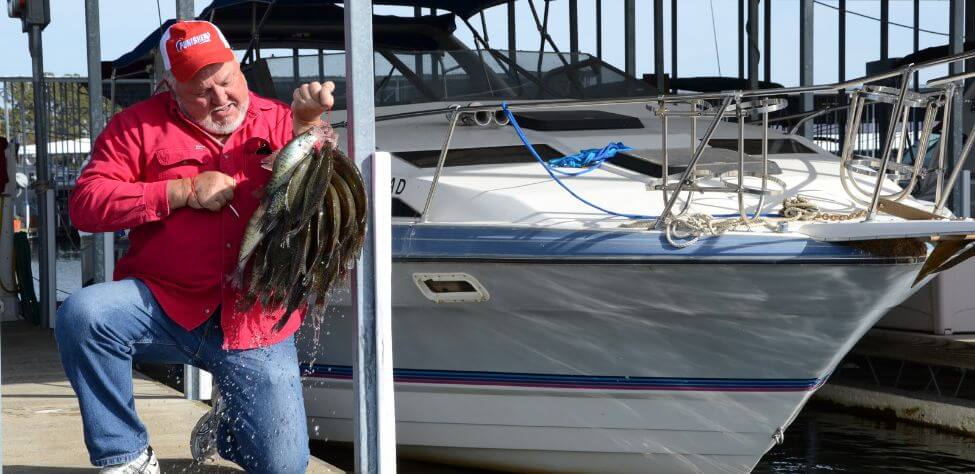
Use a Drone: Drone technology can accomplish these same tasks easily and less expensively. YouTube contains many videos on how to use drones, and a good friend of mine has had good success buying refurbished drones at cheaper prices. Drones can identify and mark waypoints efficiently, giving you the ability to hold in one position above a lake or a river to learn the places you want to fish.
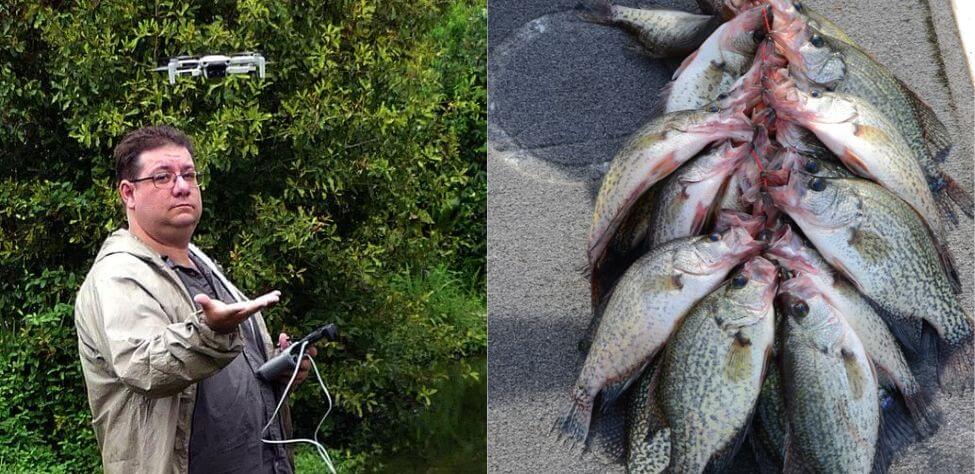
Realize How Aerial Reconnaissance Can Help: This is how you can discover where most bank-bound crappie fishermen fish. You’ll see their boats tied up or anchored to the visible cover along the bank. Mark these crappie hotspots as waypoints with your GPS receiver too. Aerial reconnaissance allows you to spot sand bars or mud flats that cut off creeks and sloughs from the main river. A promising creek will appear to have deep water and standing timber or brush in it from the air that most anglers will not see because of the mud flat or the sandbar at its mouth.
As John Holley of Linden, Alabama, an avid crappie fisherman and college friend of mine, always told me, “If you pull, push or run your boat across the mud flat or sand bar to enter the creek, you may find more and bigger crappie there than in any other section of the lake or river. I target any bay, creek or pocket that appears to have deep-enough water to hold crappie and yet remains inaccessible to most anglers. I believe these spots have had the least amount of crappie fishing pressure.”
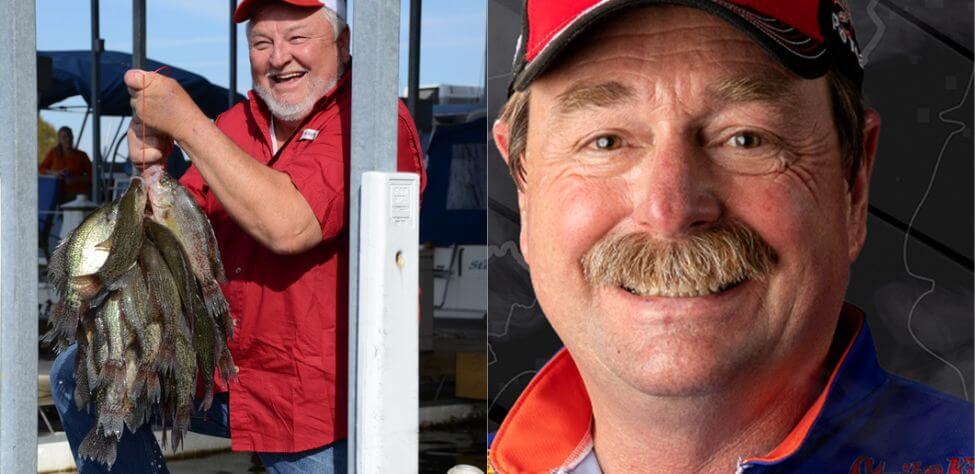
Do Boat Reconnaissance: I usually assume everyone who lives on a lake fishes for crappie and has brush piled out in front of his dock, pier or boathouse. However, look for several key features to find the docks that have brush in front of them. As you drive down the lake, search for docks and piers with rod or pole holders attached to them and chairs set up at the ends of piers and/or docks. Then often you’ll find underwater brush in front of or under the pier where you can catch crappie.
Tomorrow: Search for Crappie in Unusual Places
Expert Guidebooks on Crappie Fishing: Best Sellers
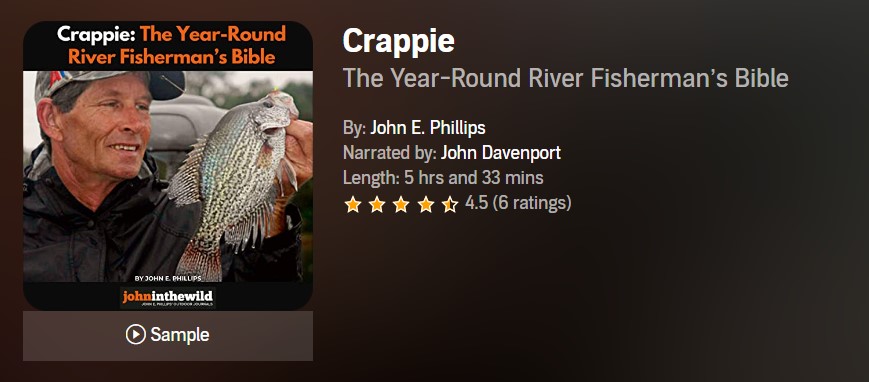
Fishing rivers for crappie and being able to find and catch speckled sides consistently has long been one of the mysteries in the crappie-fishing world.
“One of the reasons that river systems are so difficult to fish is because the water’s either rising or falling in them,” says Ott DeFoe, the 2019 Bassmaster Classic champion.
Rivers also are very susceptible to floods and droughts and constantly have current moving through them. Often fast current or slow current in rivers is created by rain or droughts upstream. When rivers flood, they can wash away fish habitat like logs, sunken trees, manmade brush piles and stake beds. But that’s the time when a river also creates new crappie hot spots that haven’t been available to the crappie or the fishermen before the flood.
Because river systems are so unpredictable, I’ve felt the best way to get the most useful information on how to fish rivers for crappie is to talk to numbers of anglers all over the nation to learn their best tactics.
In this book, I’ve gleaned crappie-fishing wisdom from three dozen crappie anglers and guides from a dozen states, who consistently catch crappie at all times of the year. The tournament crappie fishermen in this book fish most of the country at different times of the year on various river systems and lakes. And, these anglers use techniques you never may have considered, including:
- Setting up a casting ring with your electronics to keep you from getting too close to the crappie that are holding on underwater structure, while you’re fishing all the way around the structure;
- Buying an automotive laser temperature gauge to measure water temperature
- Evaluating the most-productive places to sink brush and other structure, according to prevailing wind direction, the crappie’s summer, fall, winter, and spring migration patterns, and other factors.
VERSIONS: AUDIBLE, KINDLE & PRINT
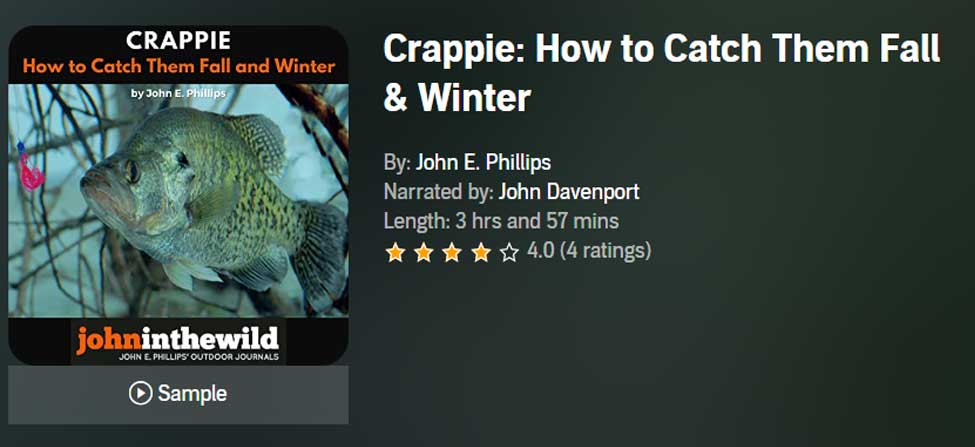
Crappie: How to Catch Them Fall & Winter
Yes, you can catch and eat crappie during the fall and winter months. Often, at many places, you’ll catch more and bigger crappies in the fall and winter than you do in the spring and summer. To learn where to find and how to catch cooler weather speckled sides, we’ve interviewed a wide variety of some of the nation’s best tournament crappie fishermen and guides.
Many of the individuals you’ll hear about in this audiobook are tournament crappie pros who travel the country to fish in crappie tournaments from New York to Florida and from Virginia to California. They use the latest crappie-finding equipment, the best poles, rods, reels, line, and the most-productive baits. Each of the people mentioned in this book has the ability to be dropped out of an airplane anywhere in the United States and catch crappie on any lake close to where they land that contains crappie.
From over 50 years of crappie-fishing experience, I’ve learned that you get the best advice by interviewing a large number of people who have different tactics and fish under various water, weather, and fishing-pressure conditions.
In this book, you will learn:
- How to spider-rig (slow-troll), which is one of the fastest-growing techniques for catching the most and biggest crappies in the shortest time
- How to catch crappie on crank baits and when and where using a crank bait is the most appropriate
- How to find areas of any lake that will hold large schools of crappies during the winter months – places you can return to time and again and expect them to be there
- Why competing in crappie tournaments is one of the quickest ways to learn how to catch more and bigger crappie faster
- Why and how to look for and catch the biggest crappie in a lake
VERSIONS: AUDIBLE, KINDLE & PRINT

Catch Crappie All Year: Fishing a Single Pole, Using No Boat, and Farming Crappie
I’ve interviewed some of the best crappie fishermen in the nation for my new audiobook, Catch Crappie All Year: Fishing a Single Pole, Using No Boat and Farming Crappie to learn how, where, and when to catch the most crappie with or without a boat while single-pole fishing. I’ve also included information on how to grow a crop of crappie to catch every day of the year. Although I’ve fished in fully rigged crappie boats costing $45,000 – $90,000-plus that can have up to 16 rods at one time to slow troll, I still enjoy….
- Watching a quill cork sink in a brush top
- Fishing with an ultralight spinning rod
- Reeling jigs or minnows along a grass line and feeling that thud when a crappie takes the bait
- Fishing with family and friends, even if we all can’t fit in one boat
- Participating in less-expensive and hassle-free yet highly-productive crappie fishing like single poling
I’ve tried to capture in this new audiobook the old way of crappie fishing with new twists and detailed tactics to aid you in catching crappie all year.
VERSIONS: AUDIBLE, KINDLE & PRINT
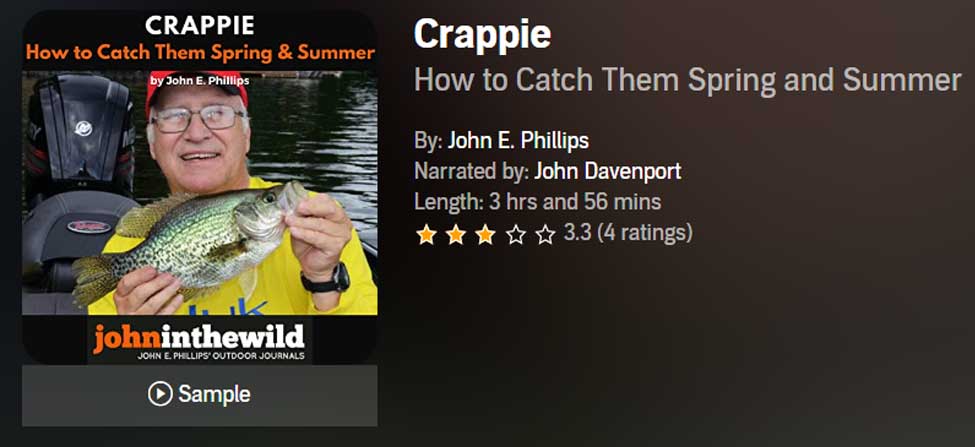
Crappie: How to Catch Them Spring and Summer
You can catch crappie all year long if you know where to find them and what techniques to use to catch them. However, crappie fishing is so technical these days, and we’ve learned so much about how to crappie fish because of the professional crappie-fishing circuits, that one book can’t hold all the information.
This book is the first of a three-part series on how, where, and when to catch crappie, with the best crappie fishermen in the nation. Many of these men have proven they are the best, because they’ve won crappie-fishing tournaments or been successful fishing guides for many years.
This audio version of Crappie: How to Catch Them Spring and Summer includes crappie pros like Ronnie Capps, who has won seven national championships and over $1 million with his partner Steve Coleman.
We also have Malcolm Lane, Stokes McClellan from North Carolina, Billy Blakeley from Reelfoot Lake, John Woods, Kent Driscoll, fishing biologist and professional basser Ken Cook, and many others. We asked the questions that crappie fishermen want answered about how to find and catch crappie during the spring and summer months, and these fishing tips are the result.
In the world of crappie fishing, no one man knows it all, and that’s why I’ve interviewed so many fishermen, asked so many questions, and tried to get so many answers for you about how to fish.
VERSIONS: AUDIBLE, KINDLE & PRINT

